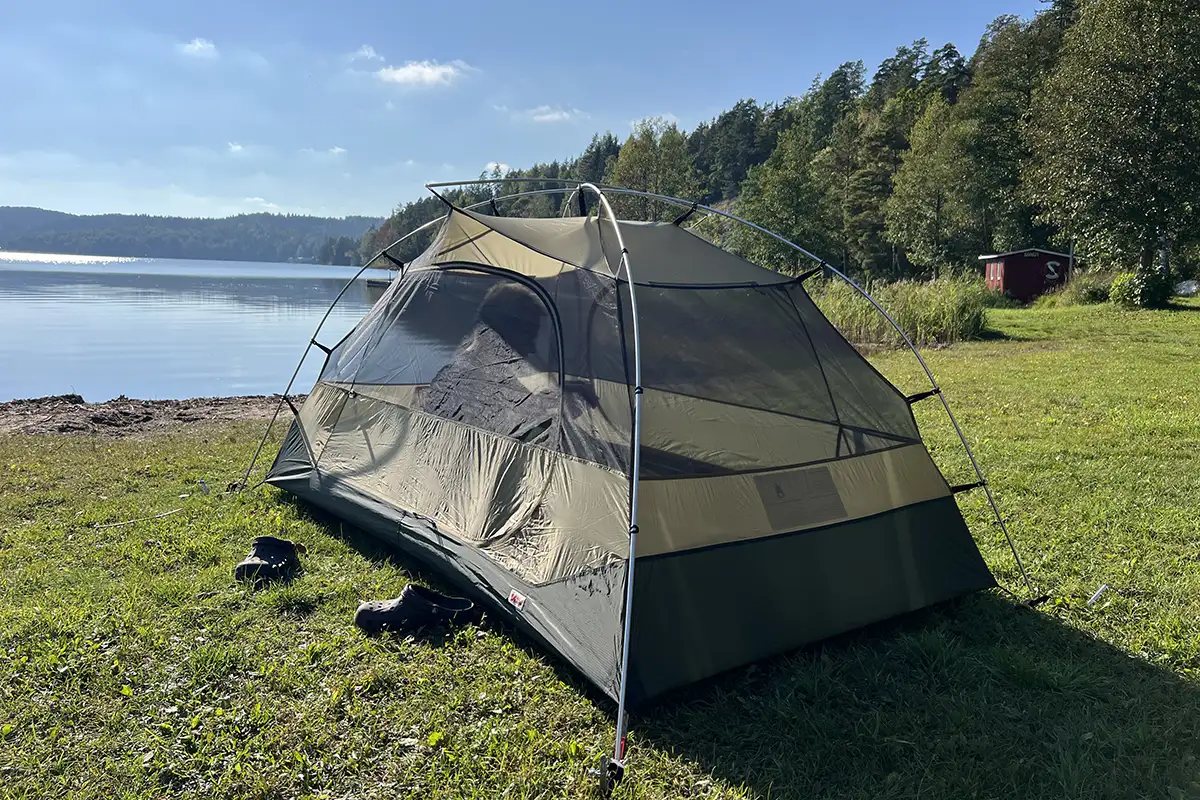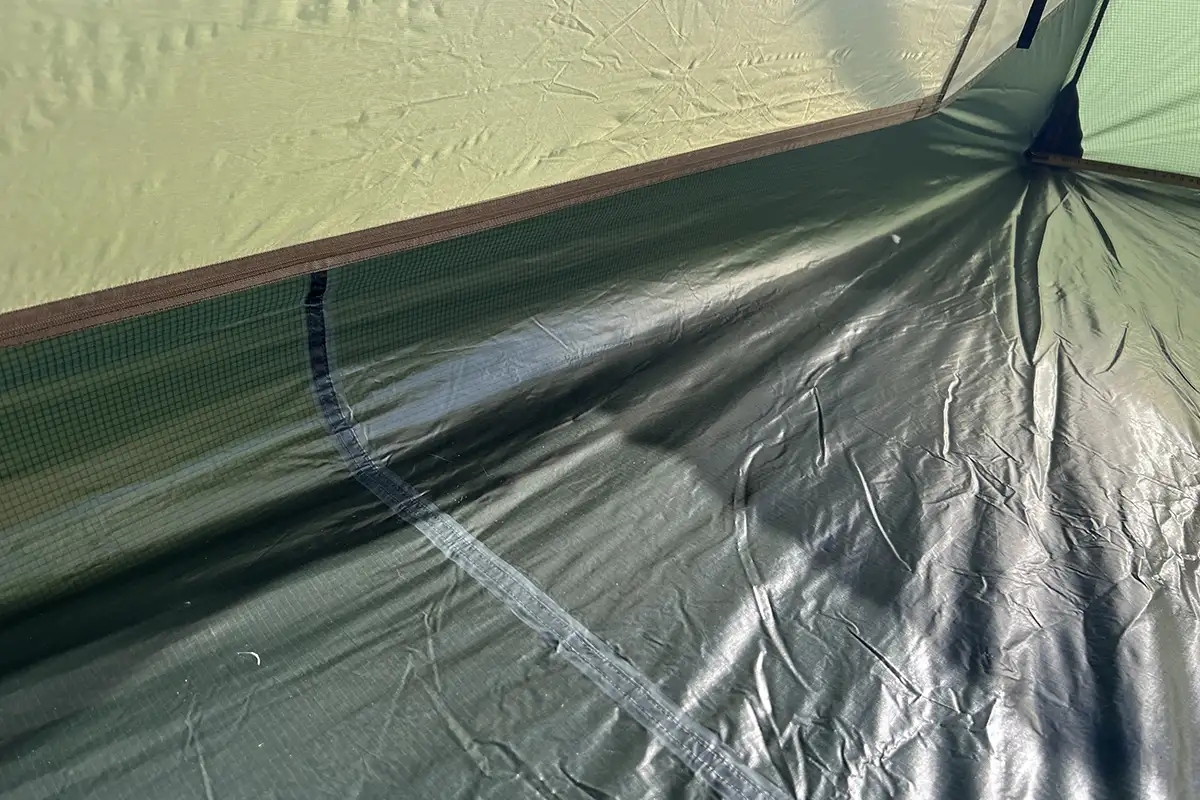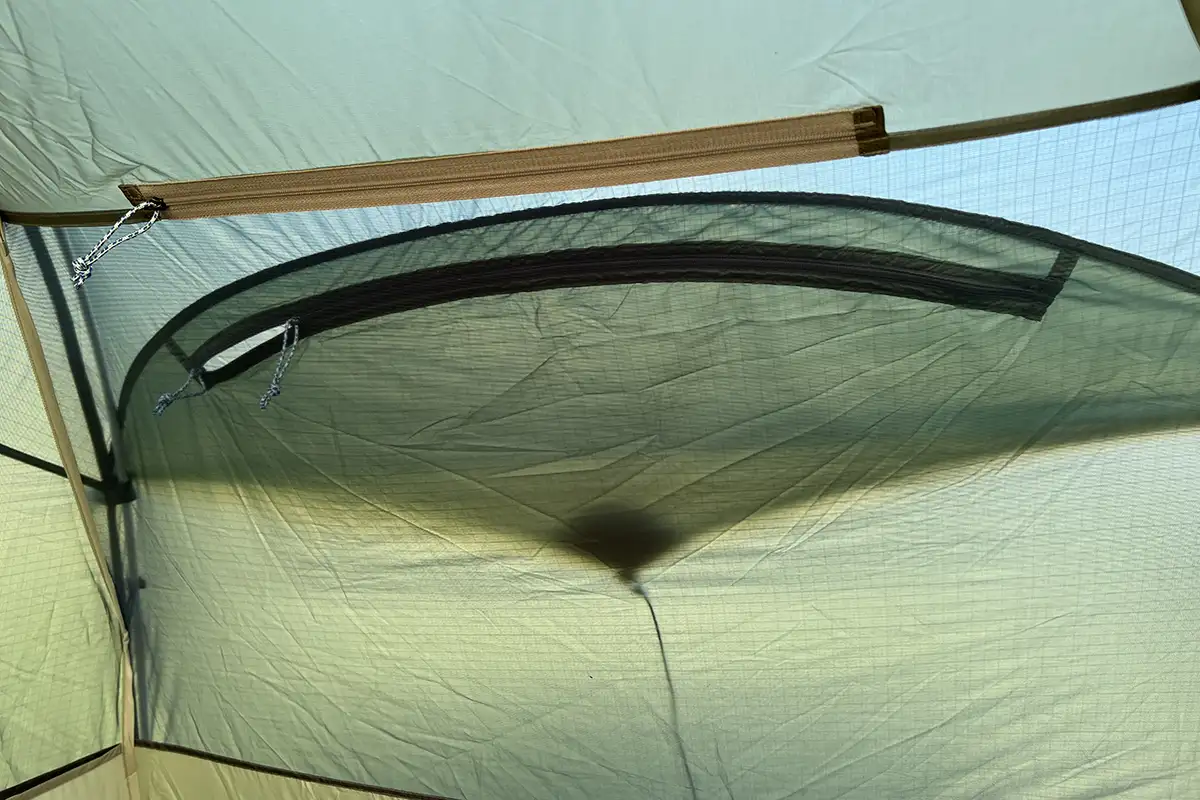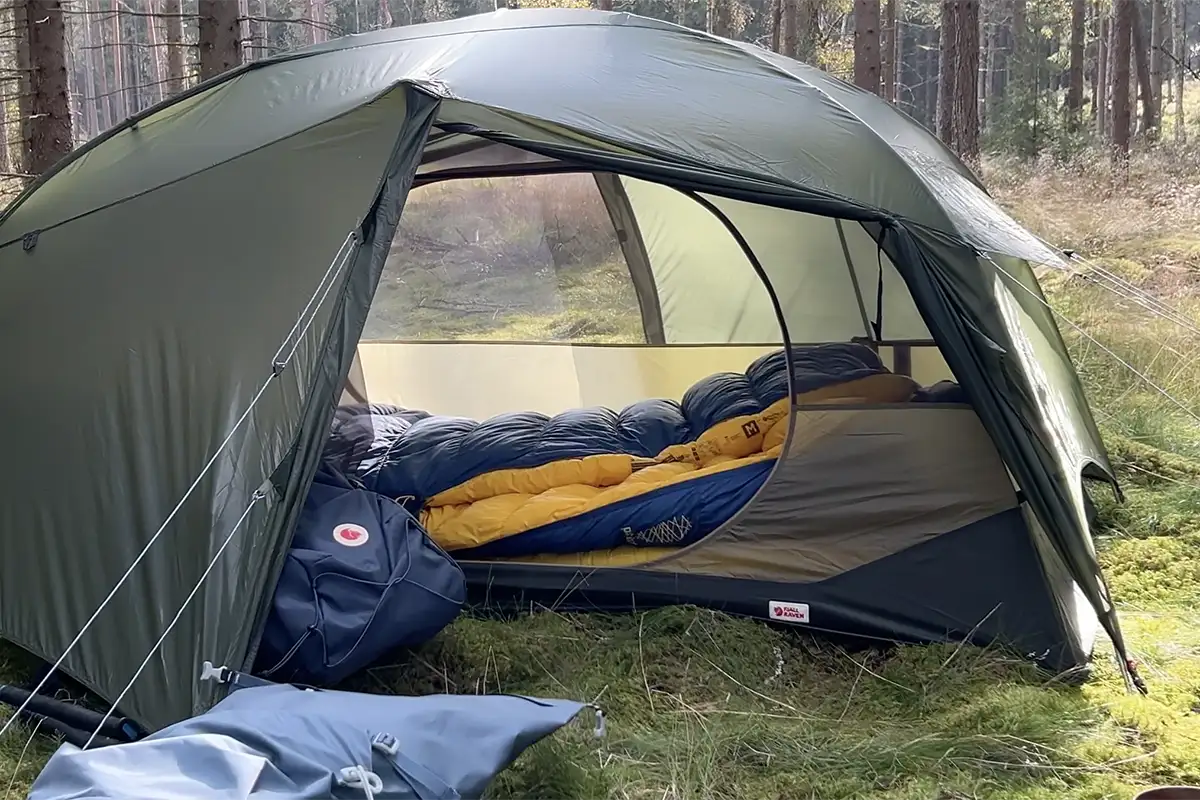The Fjällräven Abisko Friluft 2 is a lightweight, 2 person, ‘3’ season almost freestanding dome tent where ventilation is key to deal with warm summer like conditions. Next to that: it is made in an environmental friendly manner and free from PFAS. Read the review or watch the video!
- Weight: 1978,6 grams (Claimed 1900 grams)
- Packsize: 17 x 49 cm (Claimed 16 x 46 cm)
- Price: € 895,95 / £ 810.00
Packed size and weight
Just like most tent manufactures nowadays, Fjällräven mentions two weight claims; one with the complete package and one with the minimum weight: outer and inner tent and the poles only. The total weight that Fjällräven claims is 1900 grams while the minimum weight is 1680 grams.
As always I checked the weight on my calibrated scale and measured 1978,6 grams for the total package which is a bit higher than Fjällräven claims. The individual items weigh: 714,4 grams for the inner tent, 614,5 grams for the outer tent, 402,1 grams for the poles, 172,2 grams for the pouch with the pegs (12 pieces) and I weighed the stuff bag at 75,4 grams.

Stuff bag and bits and bobs
The Fjällrävens stuffbag is made from lightweight tent fabric and a rope with a toggle that closes it. It lags compression straps for a reason: the stuff bag is a rather tight squeeze for the complete set. Especially when the tent is wet, it is hard to get in the bag. I would prefer a more spacious one.
Footprint
The tent does not come with a footprint but one is available for € 69,95 / £ 65,00 (500 grams). The footprint just covers the area of the inner tent on it will not help with getting less condensation in the tent itself like Fjällräven claims on their website in a highlighted text (“floor covering the full footprint”). The website does not state if this footprint has it’s own pouch; it will be hard to fit it into the stuff bag of the itself.
Fjällräven Abisko Friluft 2: American way of pitching
Pitching the Fjällräven Abisko Friluft 2 is easy if you are used to the more American style of pitching tents. With the Fjällräven Abisko Friluft 2 you pitch the inner tent first and put the outer tent over it. It is very much the way how American tents – for example MSR – are pitched. And this way of pitching has its pro’s and con’s but later more on this. Let’s start with pitching the Fjällräven Abisko Friluft 2 first.

Note: Looking for a 100% free standing bit more spacious dome tent, than see the review of the Hilleberg Allak 3.
Poleset
The poles that Fjällräven uses on the Abisko Friluft 2 are made by the South Korean company DAC and they are the Featherlite NFL Green type with a diameter of 9.3 mm. The tent has two poles. One is a complex spider-like design that consists of the two poles that run from corner to corner and have a central hub in the top of the tent. The second pole is a short pole that provides space and headroom above the entrances. Assembling this pole is easy. The spider pole takes some effort and in foul weather with wind and rain this is no pleasure. Packing and unpacking it careful helps a lot in preventing the poles with the elastics on the inside getting tangled up.
Inner tent
Pitching the inner tent is a matter of pegging down the four corners with the small V-shaped aluminum pegs that are also made by DAC. In total the tent comes with 12 pegs. Then put the assembled ‘spider-like’ pole on top of the tent, connect it on the corners into the metal rings and raise the tent by connecting the plastic clips from the inner tent to the poles. Start with the top clip and life will be easier. Then the short second pole is put in place. This is all pretty straightforward.

Fly sheet
Putting the fly sheet over the inner tent is just like make up your bed; throw the fly sheet over the inner tent en connect it on the corners with buckles to the inner tent (two corners on the inner and fly sheet are red color coded) and to the special pockets for the pole ends of the shorter pole. Special pulling loops are provided and make life a little easier. Than use two pegs the peg down the fly fabric that creates the entrances slash vestibules. Is this all? No!
On the inside of the fly sheet there are little velcro loops that should be connected to the poles. When connected they keep the poles from sliding sideways in relation to the fly. And… they provide more stability and that makes the tent more resistant to bad weather. Connecting these loops… no matter what brand … it remains a hassle and is limiting in realising a fast pitch in nasty weather. I found the best way is just to disconnect the fly sheet at a corner, attach the loops and connect the corner again. Multiply this by four… and you are pretty wet when it rains.
Guylines
When weather is nice and with little wind there is no need to use all 8 guylines that are attached to the fly sheet. It is wise to use both guylines that are connected to the ventilation openings on either side of the Fjällräven Abisko Friluft 2 fly sheet to get the airflow going inside the tent. The 4 guy lines on the corners of the tent are directly attached to the the velcro loops so the forces are transferred to the poles making the construction quite solid with wind.
The guy lines are made of 1.7 mm Dyneema that will withstand a pulling strength of 160 kg. Positive is also that the guylines are reflective; pretty handy to find your tent back at night when you go out for a wee (and not tripping over them).

Features inner tent
The inner tent I measured at 213 cm in length and 127 cm in width. The hight is 103 cm witch makes sitting upright for me (169 cm) no problem. The floor is made out of 40 denier* polyamide fabric with a polyurethane waterproof coating and has a water column rating of 10 000 mm. All seams are taped neatly to make them waterproof. I measured the bathtub height of the floor at 15 cm.
The lower and the top part of the inner tent are made from a thin 15 denier polyamide ripstop** fabric with a DWR-coating on top. This Durable Water Repellent coating is free from PFAS and makes water bead off the fabric. More on this later. The middle part of the inner tent is made from 20D No-see-um mesh polyester that is very fine and prevents insects – even tiny midgets – getting in the tent while providing ventilation.

Symmetrical tent
Since it is a symmetrical tent both opposing doors measure 120 cm by 70 cm. Getting in en out is easy. The two way zipper – like all zippers in the tent – have good pulling tabs. Both doors can be folded away to the side and loops are provided. Or you store them in the mesh pockets that the inner tent has.
In the top of the inner tent there are two envelope style mesh storage pockets, a ‘washing’ line to air out your socks or dry a towel and there are four loops for a gear loft.
* Denier or in short D stands for the material – or rather threat – thickness. 10D is very thin and 70D is rather thick.
** In the world of lightweight tents, a Ripstop means that if there is a small hole or tear in the fabric, the material is more resistant to further tearing.
Fly sheet material
The outer tent of the Fjällräven is made of a a triple ripstop 20D polyamide fabric. To make the fabric waterproof, it is treated with a silicone coating on both sides.
When dealing with fabrics that have a silicone coating on the inside, it’s important to note that the seams cannot be taped like they can with tents that use a polyurethane (PU) coating for waterproofing. To prevent water from leaking through the stitching holes in the fly sheet fabric, a special swell yarn is used. This yarn swells when it gets wet, effectively sealing the holes. However, sometimes the holes may be too large, allowing water to seep through. While this is rare with a new tent, it can occur over time, particularly after years of use. If you do encounter this, you can use Seamseal to seal the affected areas from the inside. Be aware that sealing it on the outside can result in a messy appearance.

Features fly sheet
The fly sheet has one big zipper in the middle on both vestibules of the tent. It is a two way zipper so you can open the upper part if you want a bit more ventilation. The zippers are covered with fabric to prevent water getting to and through the zippers. To prevent the zipper covers from flapping in the wind, two velcro dots are provided. Three would be better because I did notice some flapping with higher winds. The doors can be rolled to the side and loops are provided.
Fjällräven Abisko Friluft 2 Awnings
The awnings on both sides of the Fjällräven Abisko Friluft 2 are 60-65 cm deep and although the inner of the inner tent is fine for two persons with some gear, the awnings are not specious enough to store a big backpack on either side. If you are two cyclist that use four panniers on each bike… forget about getting them al inside the tent.
Because of the zippers in the middle you have basically always shelter from the wind just by changing the attachment point to the peg. This might come in handy if you need to do some cooking. That said… there is not much space so take care!

Ventilation and condensation
Although this tent might be designed for the more weather friendly periodes of the year, rain, wind and condensation are no stranger to camping in these times. The fly sheet is designed with arches between the points where the pegs are attached to provide more windflow in the tent. This should – together with the vents – help prevent condensation. Regrettably this is not the case.
Pitched on lush grass and sleeping with two, you’ll still get quite a lot of condensation on the inside of the fly sheet during nice summer days. But… name me one tent that doesn’t suffer from condensation. That said: it is a bit less than on some other tents that look very similar to the Friluft 2 but don’t have those high arches walls. Droplets that fall from the inside of the fly onto the inner tent fabric bead of nicely; didn’t I mention that I would get back on this.
What is of course is a pro is the fact that with warm dry weather the inner tent can be used solo for optimum ventilation and bug protection. Because of the partly closed walls you do get fair bit of privacy.
Note: With a full footprint the buildup of moisture on the inside the Fjällräven Abisko Friluft 2 will be way less…

Is the Fjällräven Abisko Friluft 2 Weatherproof?
I did not have really severe wind conditions with this tent, but as far as I notice: wind is not a problem. The construction is quite solid if you attach the velcro loops and use the guy lines. The tent has proven to be waterproof too. You might wonder if the lower part of the inner tent will not suffer from rain that blows under the arches. Yes and no. Yes because it will wet but the lower part of the inner tent – the bathtub – is designed to get wet on the outside and the PU-coating of the inner tent floor will prevent water getting in the inside. So. All is well here!
By the way… Don’t expect a weatherproof entry in the tent when it rains and although the doors to the inner tent are fine, I find the the entry through the fly pretty narrow whit rainy weather.

Verdict
The Fjällräven Abisko Friluft 2 is a little bit of a stranger in the tent collection of this Swedish outdoor giant. And to be honest… I don’t love the tent. The main reason being the fact that is a very American way of thinking about tents where one pitches the inner tent first and then the fly sheet. To me – living in Northern Europe – it’s not the way to go because pitching and breaking down the tent in rainy weather will always end up with more wet stuff than I want. That is definitely a con. Next to that… there are enough (US) brands that already do it this way. Maybe if it was designed for the US market, I would understand, but it is not for sale in the US.
Pitching the Friluft 2 is pretty easy but connecting the velcro straps remains a hassle. Handle the spider like pole with care; the parts snap quite easy into each other resulting in little dents that might getting the poles together harder. The pegs are of good quality and the tent has enough guylines. They are reflective and that is a bones.
The inner space is fine for two if both persons are not too big. A bit of space remains for some luggage. The vestibules are on the small side. A not to big backpack is possible on both sides, four panniers per cyclist is impossible. The entry in the inner tent is fine, but the main entry in the outer tent could be a bit more generous.
The tent has proven to be waterproof and quite windproof. Despite the arched sides of the fly sheet and the vents, the two person tent remains vulnerable for condensation. A pro on the other hand is that de inner tent can be pitched solo for bug protection when weather is dry and warm.
In one respect the Fjällräven Abisko Friluft 2 is absolutely different than a lot of other look-a-likes: it is free from PFAS.
The Fjällräven Abisko Friluft 2 is average in weight and packed size and also the available space is not significantly more or less than others in the same league. The price of € 895,95 / £ 810.00 is on the top end of the scale for a tent like this. I rate the Fjällräven Abisko Friluft 2 at 8.1 out of 10 total.
Information: www.fjallraven.com
